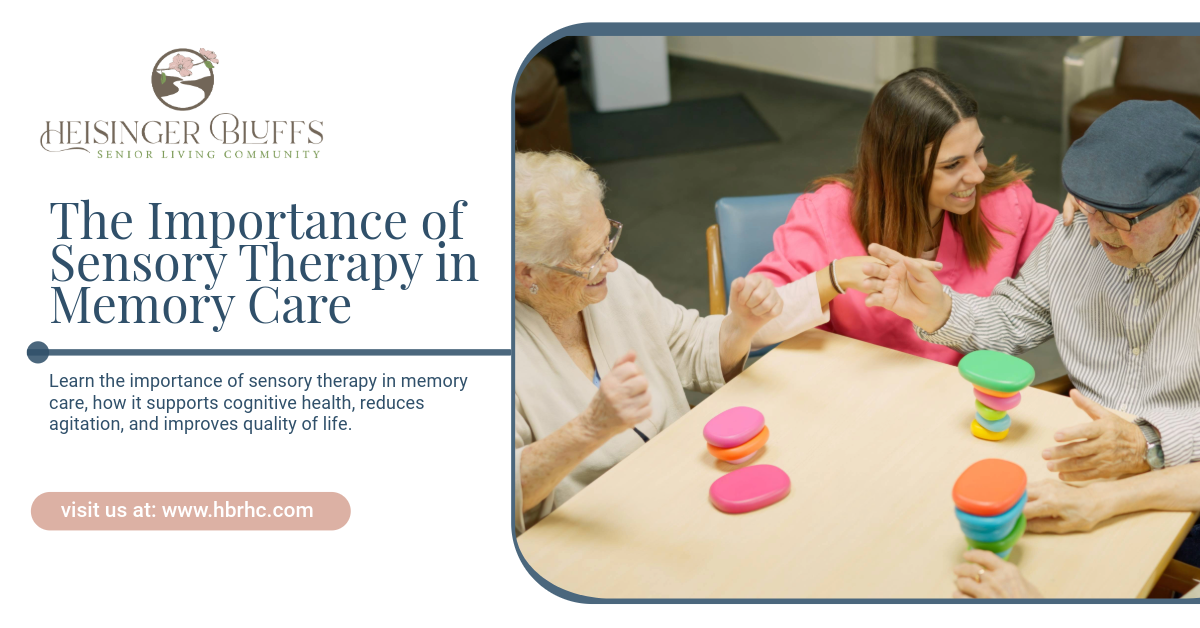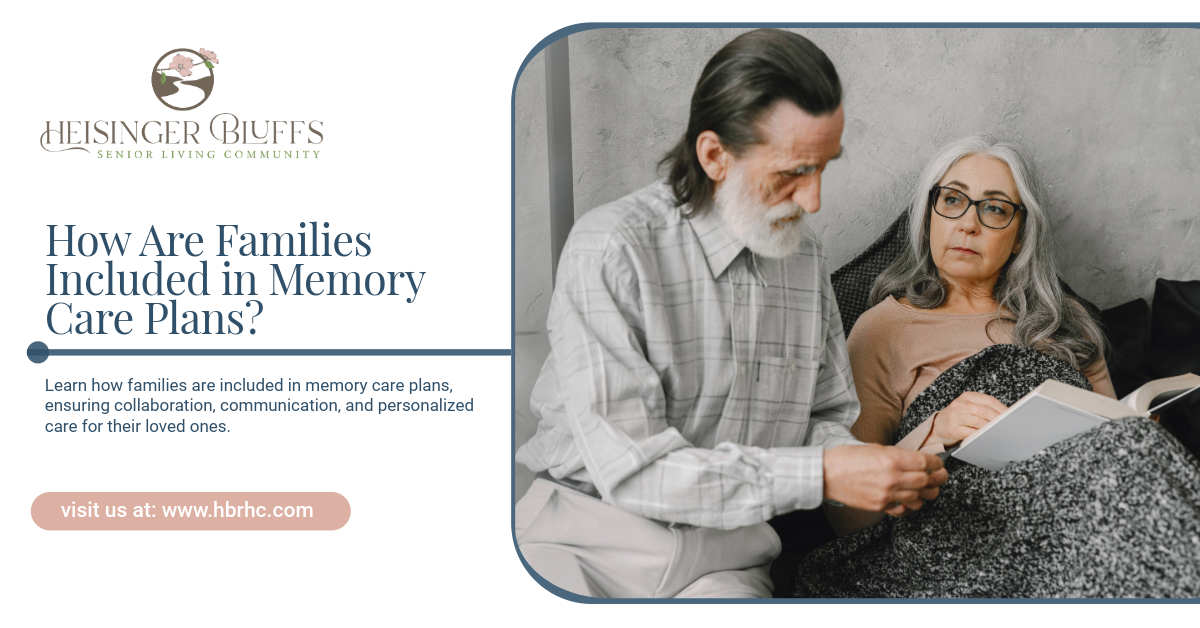The Importance of Sensory Therapy in Memory Care

Caring for individuals with Alzheimer’s disease or other forms of dementia involves more than just medication and routine assistance, it requires engaging the whole person. One powerful approach that’s gaining attention in memory care is sensory therapy. This form of therapy uses sight, sound, touch, taste, and smell to evoke positive emotions, stimulate memory, and improve communication.
Sensory therapy is not just a trend. Backed by neuroscience and decades of research, it provides a meaningful, person-centered way to connect with individuals who may struggle with verbal communication or memory loss. For many, it’s a doorway to comfort, calmness, and connection.
This blog explores how sensory therapy works, why it’s essential in memory care, and the real-life benefits it brings to seniors and their families.
What Is Sensory Therapy?
Sensory therapy is a therapeutic approach that involves stimulating one or more of the five senses—sight, sound, touch, taste, and smell—to trigger positive memories and emotions, or to promote calm and engagement. It can be applied through activities, objects, environments, or interactions.
Examples of sensory therapy include:
- Listening to familiar music
- Handling textured objects or fabrics
- Smelling lavender, vanilla, or baked goods
- Watching nature scenes or light projections
- Tasting favorite comfort foods
This kind of therapy is especially useful for people with dementia, who often have difficulty communicating verbally but retain emotional memories associated with sensory input.
Why Sensory Therapy Matters in Memory Care
Memory-related conditions like Alzheimer’s disease cause damage to the brain’s communication pathways, making it difficult for individuals to process information, express needs, or stay oriented. However, the brain often retains sensory memories long after other cognitive functions decline.
That’s where sensory therapy becomes so valuable.
Key benefits include:
- Reduces agitation and anxiety
- Improves communication and expression
- Strengthens emotional connections
- Encourages participation in daily activities
- Improves mood and quality of life
Let’s take a closer look at how each sense plays a unique role in memory care.
Engaging the Senses: How Each One Helps
1. Sight (Visual Stimulation)
Visual cues can help orient individuals with dementia and promote calmness or joy. Bright, contrasting colors, nature scenes, and familiar photographs can spark recognition and engagement.
Therapeutic tools include:
| Visual Tools | Benefits |
|---|---|
| Family photo albums | Spark memories and conversations |
| Light projectors or fish tanks | Provide calm, rhythmic movement |
| Contrasting colors in décor | Help with spatial awareness |
Why it matters: Visual stimulation provides familiarity and focus, reducing confusion and improving comfort in unfamiliar environments.
2. Sound (Auditory Stimulation)
Music is one of the most powerful sensory therapies for people with memory loss. Familiar songs can unlock deep emotional memories and encourage verbal expression.
Examples include:
- Playing oldies or favorite childhood music
- Nature sounds like ocean waves or birdsong
- Gentle instrumental tracks during meals
Why it matters: Auditory input, especially music, stimulates brain areas related to emotion and memory—even in later stages of dementia.
3. Touch (Tactile Stimulation)
Seniors with dementia often find comfort in touching and manipulating familiar or soothing textures. These can promote calmness, reduce restlessness, and even improve motor skills.
Tactile activities might involve:
| Tactile Tools | Purpose |
|---|---|
| Fidget blankets or activity aprons | Help with restlessness and focus |
| Warm towels or soft blankets | Provide comfort and calm |
| Gardening or clay modeling | Stimulate fine motor control |
Why it matters: The sense of touch offers grounding and emotional security, especially for residents who may be nonverbal.
4. Smell (Olfactory Stimulation)
Scents are closely tied to memory and emotion. The brain’s olfactory center is located near areas involved in memory, which is why familiar smells can immediately trigger past experiences.
Examples include:
- Baking cookies or fresh bread
- Using essential oils like lavender or peppermint
- Scented memory boxes with soaps, herbs, or flowers
Why it matters: Certain smells can reduce agitation, stimulate appetite, or bring a comforting sense of home.
5. Taste (Gustatory Stimulation)
The act of tasting favorite foods or drinks can bring comfort and joy. It also helps promote nutrition and hydration in seniors who may otherwise struggle with mealtime.
Taste therapy might involve:
- Sipping warm tea or cocoa
- Offering small samples of familiar holiday foods
- Incorporating herbs or spices with nostalgic value
Why it matters: Tastes can unlock deeply embedded emotional memories and boost appetite, helping maintain health and well-being.
Sensory Rooms: Safe Spaces for Exploration
Many memory care communities use sensory rooms, carefully curated spaces designed to safely stimulate multiple senses at once. These rooms are tailored to reduce stress and promote calm, using:
- Soft lighting
- Aromatherapy diffusers
- Music or sound machines
- Tactile panels or fidget tools
- Calming images or nature videos
Benefits of sensory rooms:
| Outcome | How It Helps |
|---|---|
| Decreases agitation | Creates a calming environment |
| Increases focus | Reduces sensory overload in busy settings |
| Encourages interaction | Offers structured, meaningful stimulation |
These spaces can be personalized based on each resident’s preferences, history, and cognitive stage.
How Sensory Therapy Supports Cognitive Function
While dementia is a progressive condition, sensory therapy can help preserve and even strengthen certain neural pathways by:
- Reinforcing long-term memory retrieval
- Encouraging brain stimulation through nonverbal pathways
- Providing positive emotional feedback
- Reducing stress, which improves attention and awareness
Research shows that multi-sensory stimulation can improve mood, communication, and behavior in people with dementia, especially when it’s consistent and personalized.
Making It Personal: Tailoring Sensory Therapy to Each Individual
Effective sensory therapy isn’t one-size-fits-all. The best results come from creating personalized experiences based on each person’s history, preferences, and stage of cognitive decline.
For example:
| Resident Background | Personalized Sensory Tool |
|---|---|
| A retired gardener | Potting herbs or smelling soil |
| A former musician | Listening to classical symphonies |
| A homemaker | Folding laundry with lavender scent |
| A teacher | Reading or listening to children’s books |
These tailored activities help residents feel seen, valued, and connected to their identity.
Real-Life Impact: How Sensory Therapy Changes Lives
Here’s a glimpse into how sensory therapy can transform a resident’s experience:
- Mary, a woman in her 80s with mid-stage Alzheimer’s, had difficulty communicating and often appeared withdrawn. During a music therapy session, a caregiver played one of her favorite songs from her teenage years. Mary began to hum along, then smiled—her first in weeks.
- Tom, a retired mechanic, struggled with restlessness and pacing. In the sensory room, he was given a fidget board with switches and knobs. His hands immediately began to explore the tools, and he remained calm and engaged for 30 minutes.
These small but meaningful moments are what make sensory therapy so powerful.
Supporting Families Through Sensory Therapy
Families often feel a mix of grief and helplessness when a loved one with dementia becomes hard to reach. Sensory therapy offers new ways to connect—through a shared song, scent, or memory.
Ways families can participate:
- Create a memory box together
- Share favorite recipes and assist with tasting activities
- Join music or aroma therapy sessions
- Help personalize a sensory corner in their loved one’s room
These interactions often restore a sense of closeness and shared joy.
Bringing Sensory Therapy into Memory Care Communities
More memory care communities are integrating sensory therapy into their daily routines, including:
- Music and aroma during mealtimes
- Tactile materials in common areas
- Scheduled sensory activities like baking or painting
- One-on-one sensory sessions for anxious residents
This holistic, compassionate approach ensures that care goes beyond medical needs to support emotional and spiritual well-being.
A Sensory-Inspired Approach to Better Living
Sensory therapy taps into the enduring power of human connection—through a favorite song, the feel of warm hands, or the scent of fresh cookies. For seniors living with memory loss, these moments matter more than words.
At Heisinger Bluffs, our memory care program embraces sensory therapy as a core part of compassionate, person-centered care. We believe in meeting each resident where they are, using all five senses to spark joy, comfort, and belonging every day. Reach out to us today!
Frequently Asked Questions
Is sensory therapy effective for people in late-stage dementia?
Yes. Even in the later stages of dementia, individuals often respond to sensory input, particularly music, touch, and familiar smells. Sensory therapy can help reduce agitation and provide comfort even when verbal communication is limited.
How often should sensory therapy be used in memory care?
Ideally, sensory therapy is part of the daily routine. Whether it’s through background music, a tactile activity, or a mealtime aroma, consistent exposure improves outcomes over time.
Can family members help with sensory therapy?
Absolutely. Families can contribute personal items, help create memory boxes, or participate in shared activities like music or baking. Their involvement often makes the experience more meaningful for the resident.
Sources:
- https://pmc.ncbi.nlm.nih.gov/articles/PMC10969171/
- https://www.mayoclinic.org/diseases-conditions/alzheimers-disease/symptoms-causes/syc-20350447
- https://communityneuroservices.com/the-power-of-scent-how-smell-influences-memory/
- https://www.alzheimers.org.uk/about-dementia/symptoms-and-diagnosis/how-dementia-progresses











